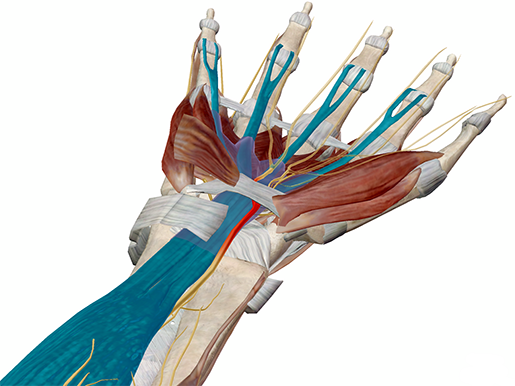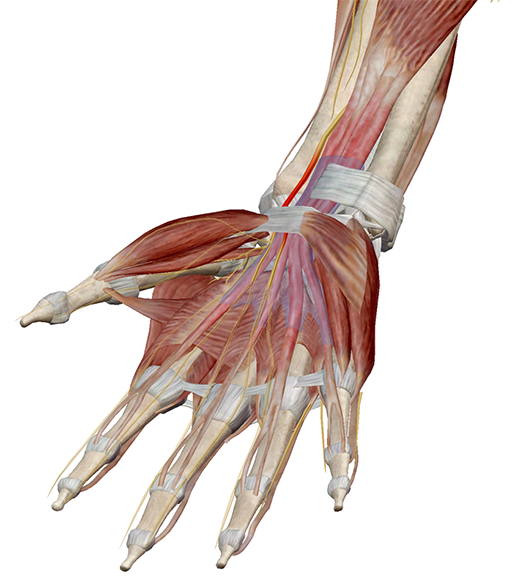Into The Carpal Tunnel: Anatomy & Pathology of Carpal Tunnel Syndrome
Posted on 2/18/16 by Courtney Smith
It's what strikes fear into the heart of every frequent typist (like myself): carpal tunnel syndrome. I just shuddered as I typed that. It's usually referred to as "carpal tunnel," but the thing is that everyone has a carpal tunnel. Well, everyone has two: one in each hand. But not everyone is affected by carpal tunnel syndrome (or CTS). About 3% of women and 2% of men will be diagnosed with CTS during their lifetime, with women at 3x the risk than men. That's over 9 million people in the United States alone.
But what is it exactly? Why is it such a common ailment? Why do more women have CTS than men? Why do some people have issues with their carpal tunnel while others don't? All very good questions. And my beleaguered wrists and fingers will do the answering.
What is the carpal tunnel?
The carpal tunnel is an actual tunnel created by the tendons, tissues, and bones in your wrists and hands. Think of the bones of your arm, wrist, and hand as a road. The flexor retinaculum and the palmar carpal ligament work like an overpass, and the flexor tendons of your hand and the median nerve pass under it like a car.
 Image captured using Muscle Premium.
Image captured using Muscle Premium.
The flexors -- the flexor digitorum superficialis, the flexor pollicis longus, the flexor carpi radialis, and the flexor digitorum profundus (highlighted in blue) -- are muscles that originate in your forearm, but insert into the finger bones as tendons (which means technically you don't have muscles in your fingers). These tendons are what allow your fingers to flex, hold things, type, and do pretty much any task you can dream of. Also, when you bend your wrist, you are working the flexors in your forearms, as well as the tendons.
Poke the palm of your hand. That you felt anything at all is all thanks to the median nerve. The median nerve is part of the brachial plexus, which is a network of nerves in the shoulder and upper limb. It supplies sensation to the palm, the side of the thumb, and the index, ring, and middle fingers, as well to the flexor tendons. It also gives function to the muscles at the base of the thumb.
Carpal Tunnel Syndrome Symptoms
I can hear you asking, "If the body has this nice little system going with the muscles, tendons, and the median nerve… why in the world does that system break down?"
The thing is, no one is really sure what leads to carpal tunnel syndrome. CTS is caused by the tissues and tendons around the median nerve (with nerve branches, highlighted in blue) swelling and pressing on the nerve. This reduces oxygen flow to the nerve, which means the signals to the nerve slow. In some cases, it's not the tendons that swell but the nerve itself.
The compression of the median nerve results in pain, numbness, parathesia ("pins and needles"), and a feeling of coldness in the wrist and hand -- with the exception of the little finger. The median nerve does not provide sensation to the little finger and therefore it remains unaffected.
 Image captured using Muscle Premium.
Image captured using Muscle Premium.
Why is CTS so common?
CTS is associated with repetitive actions that directly affect the wrist/hand area, such as frequent typing or computer use, but manual labor is actually the occupation with the highest CTS risk. Musicians, welders, sheet metal workers, cooks/chefs, laborers in the freight and/or moving industry, and office workers are at the highest risk for CTS. Think of how much you use your hands and fingers during the day to complete certain tasks. I, myself, am well on my way.
Can you prevent carpal tunnel syndrome?
So, how do you prevent it? If you catch it in the early stages, CTS is reversible. There are two key strategies to stopping the onset of CTS: rest and ergonomics.
- Rest periods are important, especially for you heavy typists out there. Resting your fingers for short periods of time (3 minutes or so) will be enough time for the tissues to relax. Shaking your hands out to loosen things up is always a good idea too.
- Ergonomics is also very important. Ergonomics is the efficient interaction between you and your workspace. For example, when you use a computer, do you have a wrist rest for your keyboard or mouse? Wrist rests are not only for comfort but they help keep your wrists and hands parallel to the device you're using, easing the strain on the muscles. How about your chair? Does it have arm rests? Is the back positioned to encourage good posture? The same goes for those who use tools or manual equipment. Make sure what you use does not put unnatural stress on your wrists. If you use, say, a wrench, make sure that when you hold it for use your wrists are in the same, comfortable position they'd be in if your arms were hanging at your side.
CTS is easy enough to prevent, but if you've been experiencing CTS symptoms for a while you may be a bit out of luck as far as reversing it. But adopt some good habits and you'll prevent the symptoms from worsening.
There you have it: carpal tunnel syndrome, demystified. Now it's time to give my fingers a break.
Be sure to subscribe to the Visible Body Blog for more anatomy awesomeness!
Are you a professor (or know someone who is)? We have awesome visuals and resources for your anatomy and physiology course! Learn more here.
Related Posts:
- Anatomy and Physiology: Carpal Tunnel Demystified, Part 2
- Anatomy and Physiology: Homologues of Reproductive Anatomy
Additional Sources:
Carpal Tunnel Syndrome: New York Times.






